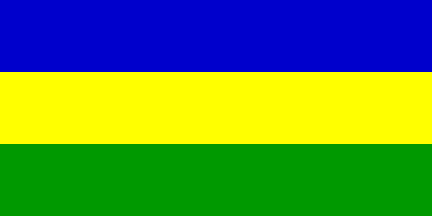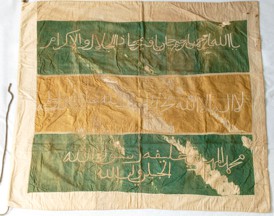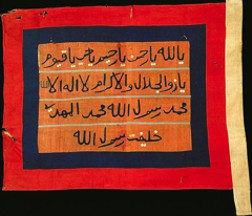 Image by Clay Moss, 16 Dec 2006
Image by Clay Moss, 16 Dec 2006
Last modified: 2025-04-12 by bruce berry
Keywords: sudan | africa | arab | mahdi | crescent and spear | lado | rivers | customs | magen david |
Links: FOTW homepage |
search |
disclaimer and copyright |
write us |
mirrors
See also:

![[National Flag and Civil and State Ensign]](../misc/ooooox.gif) 1:2
Image
by Željko Heimer, 24 Jan 2003
1:2
Image
by Željko Heimer, 24 Jan 2003First flag of independent Sudan was a blue over yellow over green tricolour
was officially adopted at independence on 01 January 1956 although the flag had
been use since 1954.
Jaume Ollé, 03 Mar 1996
The Egyptian Constitution of 1948 made provision for the incorporation
of Sudan. However, Sudan became a kingdom after 1951 when Faruk was proclaimed King of Sudan.
In opposition to the proposed incorporation into Egypt, Great Britain defended the right of self determination
in Sudan. After the revolution of 1952, the new government agreed on the issue of
Sudanese independence and autonomy was established in 1953. Parliament was
opened 1954 and later announced that independence would be proclaimed on 01
January 1956.
Jaume Ollé, 03 Oct 1999
There was a hijacking of a Sudanese airliner to Stansted airport here
in England recently. In one newspaper report there was a colour photo
of the airliner on the ground at the airport, and whilst it had the
current Sudanese flag (in the "Arab Revolt" colours of red, white,
green and black) painted on the fuselage by the cockpit, the "flash"
(or what I believe is called the "cheat line") of the airline's livery
along the length of the aircraft was clearly in the colours of the old
blue over yellow over green flag used from independence in 1956 until
1970.
Roy Stilling, 03 Sep 1996

![[Naval Ensign]](../misc/xxxxxo.gif) 1:2
Image
by Željko Heimer, 24 Jan 2003
1:2
Image
by Željko Heimer, 24 Jan 2003
Pre-1969 naval ensign was white with the national flag in canton.
Jaume Ollé, 03 Mar 1996
During the Anglo-Egyptian Condominium (1899 until 1956) there was no individual flag for Sudan. Instead the two flags of Egypt and the United Kingdom were used, with the British flag taking precedence.
 Image by Clay Moss, 16 Dec 2006
Image by Clay Moss, 16 Dec 2006
The Egyptian flag changed three times during the Condominium
period: up until 1914 it was red with a crescent and star (as for the Ottoman
Empire); between 1914 and 1923 it was red with three crescents and three stars; and
finally between 1923 and 1954 it was green with one crescent and three stars. I believe that
although the Condominium ended in 1956, the blue-yellow-green flag of Sudan was hoisted in 1954. Flags Through the Ages
and Across the World (1975) by Whitney Smith
[sme75b] has a photo (p.153) of the two flags with the following text: 'Therefore the flags of these two countries were flown jointly, with the Union Jack always taking precedence - except in the city of Suakin, where Egyptian flag flew alone'. Why was Suakin an exception?
Željko Heimer, 06 Oct 1996
In my Allers Illustrerede Konversations-Leksikon, Copenhagen 1906-10, I found an
article on Suakin. It seems that the city itself (lying on an island)
belonged to Egypt, while the hinterland and the mainland town, El Kef (Gef),
belonged to Anglo-Egyptian Sudan which probably explains why only the Egyptian
flew in the city.
Ole Andersen, 04 Jan 1999
 image
sent by BlinxCat, 05 Dec 2022
image
sent by BlinxCat, 05 Dec 2022
Some sites attribute the flag
illustrated above as being an ensign for Anglo-Egyptian Sudan but I cannot
verify the sources.
BlinxCat, 05 Dec 2022
This flag is completely fictitious,
although it has been sold by some flagmakers since at least 2013.
Some sources attribute the design to the period from 22 October 1952 to independence
on 01 January 1956. It is claimed to have been the flag of the State of
Anglo-Egyptian Sudan, something that did not exist. Self-government was proposed
for Sudan in 1952 but Egypt objected to the arrangements and it was not until
January 1954 that self-government was achieved as part of a three year
transition to independence.
 image sent by Ralph Kelly, 05 Dec 2022
image sent by Ralph Kelly, 05 Dec 2022
The design is from the Khedive's Sudan Medal of 1911 - 1926.
Ralph Kelly, 05 Dec 2022
Interim Flag (1955)
 Image by Nozomi Kariyasu, 15 Jan 2021
Image by Nozomi Kariyasu, 15 Jan 2021
For a short period before the
adoption of the new flag on 01 January 1956, a white flag with "Sudan" in red in
the centre was used. This flag was displayed during Afro-Asian Conference
(18-24 April 1955) in Bandung (Indonesia) where 29 countries participated.
Nozomi Kariyasu, 15 Jan 2021
This flag was created solely for the
Afro-Asian Conference in April 1955 in Bandung, Indonesia at which the Sudan was
represented. The organisers wanted to display the national flag of each of the
countries attending and since there was no flag for the Sudan, they just made up
a flag with the word SUDAN in red on a white background, to fill the gap in the flag
array. It had no official status in the Sudan and, I believe, it was not
used at any other location or event prior to independence when the blue, yellow
and green horizontal tricolour was adopted.
Ralph Kelly, 05 Dec 2022
Flag of the Governor-General of Anglo-Egyptian Sudan
 Image
by Jaume Ollé, 03 Oct 1999
Image
by Jaume Ollé, 03 Oct 1999
GOVERNOR GENERAL OF THE SUDANon the white disc as no Arms or badge existed for the Condominium.
G.W. Stevens in his With Kitchener to Khartoum refers to a few Mahdist
flags. At the battle of Omdurman, he mentions the "black banner of the
Kahlifa's brother" and the "blue and white banners of his son". Khalifa
Abduallah el Taashi was successor to the Mahdi. War artist H.C. Seppings Wright
(who was at the battle of Ombdurman, I think) has done a painting of the aftermath
of the massacre in which the dead Mahdists are still holding upright the Kahlifa's
black flag.
T.F. Mills, 06 Aug 1996
 Image
by Mark Sensen, 06 Aug 1996
Image
by Mark Sensen, 06 Aug 1996
 Image
by Mark Sensen, 06 Aug 1996
Image
by Mark Sensen, 06 Aug 1996
I have a copy of a letter dated 11 September 1952 from the Sudan Government Civil
Secretary's Office, Public Relations Branch to Dr Ottried Neubecker with a
drawing of the Mahdists' flag hoisted over the party headquarters. The standard version
of the flag is a horizontal black-red-green tricolour with a white crescent
(pointing upward) and spear overall in the center. Another version had the crescent
and spear in the black stripe at the fly.
Mark Sensen, 06 Aug 1996
"Le Quotidien du Pharmacien", 20 February 2006, has a report entitled "Dans le nord du Soudan - Sur les traces des pharaons noirs" (In the north of Sudan - On the steps of the black pharaohs". The report ends with a quote from a traveler from the XIIIth century (therefore long after the pharaohs!):
"Dongola has seven impregnable stone walls, wide streets, churches with frescos and paintings on fabric. The king's house is very high, with red brick domes. His Majesty has a white flag charged with the cross and excellent horses; its army uses russet dromedaries."Source: http://www.quotipharm.com/journal/index.cfm?fuseaction=viewarticle&DArtIdx=363616
Dongola, aka Dunqulah, is located on the Nile, 500 km north-north-east of Khartoum; it is the capital city of the province of Ash-Shamaliyah (North).
The aforementioned article gives also details on the Mahdi, whose flags are shown above.
Muhammad Ahmad ibn Abd Allah (1844-1885) proclaimed himself the Mahdi in 1881. In the Islamic tradition, the Mahdi, lit., the Well Guided, shall be sent by God at the end of the times to restore faith and justice on the Earth. The Mahdi stirred up the country against "the infidel foreigners" (the British) and "the impious Turks". General Charles Gordon (1833-1885, aka Gordon Pasha), Governor of Sudan in 1877-1880 was called back from Britain to restore law and order. He was surrounded and killed in Khartoum in 1885. The Mahdi died six months later.
Twelve years later, Britain sent an expedition involving 25,000 men in
order to control the Nile and to get rid of the Caliphate, a
self-proclaimed religious and military dictatorship of Mahdist origin.
The expedition was related by Winston Churchill in his book "The River
War". The British armies defeated the Mahdists in Omdurman and Atbara.
Lord Herbert Kitchener (1850-1916) was ordered to exhume the Mahdi's body
and to behead it. The head was sent to Queen Victoria, who was offended
by the present.
Ivan Sache, 21 February 2006
 Image by Jaume Ollé, 19 Nov 1996
Image by Jaume Ollé, 19 Nov 1996
 Image
by Jaume Ollé, 03 Oct 1999
Image
by Jaume Ollé, 03 Oct 1999
The flag of the 1924 revolt is white with the Egyptian flag in canton
showing a map of the White Nile, Blue Nile and Atbara rivers in the fly. The flag
was used by the nationalist movement called "White Flag League" which was very
active in the 1920s (Source : Yuri Kurasov in Flaggenmitteilung 29 [fml].
Jaume Ollé, 03 Oct 1999
 image located by William Garrison, 2 November 2023
image located by William Garrison, 2 November 2023
From https://makingafricanconnections.org/s/archive/item/455:
[1880s] Banner carried by Anṣār (الأنصار) in battle. Fine silk fabric sewn together in three strips (green/gold/green), with white cotton appliqued lettering and border of rough local cotton. The name of the Sufi mystic, ʿAbd-al-Qādir al-Jīlānī, is spelled incorrectly. The elegant Arabic script reads:
يا الله يا رحمن يا رحيم يا حي يا قيوم يا ذالجلال والاكرام
yā allah yā raḥman yā raḥīm yā ḥayy yā qayūm yā ḍhi’l-jalāl wa’l-ikrām
Oh Allah, O the compassionate, O the merciful | O ever-living, O everlasting, O Lord of Majesty and Generosity
لا الله الا الله محمد رسول الله صلي الله عليه وسلم
lā illah ill’allah muḥammad rasūl allah ṣalla allah ʿaleyhi wa sallam
There is no god but Allah [and] Muḥammad is the Prophet of Allah | The blessings and peace of God be upon him
محمد المهدي خليفة رسول الله الجيلي ولي الله
muḥammad al-mahdī khalīfat rasūl allah al-jīlī walī allah
Muḥammad the Mahdī is the successor of the Prophet of Allah [and] al-Jīl[ān]ī is a friend of Allah
See also:
William Garrison, 2 November 2023
 image located by William Garrison, 2 November 2023
image located by William Garrison, 2 November 2023
 image located by William Garrison, 10 February 2024
image located by William Garrison, 10 February 2024
From
https://www.si.edu/object/nmafa_91-20-1:
An early 1880s Sudanese
flag in the U.S. "National Museum of African Art" which is part of the larger
U.S. Smithsonian museum system.
The lines on this flag read from top to
bottom:
"Oh, Allah ... Oh, Merciful ... Oh, Compassionate ... Oh,
Ever-living... Oh, Unchanging"
"Oh, Lord of Majesty and Mercy ... There is no
god but Allah"
"Mohammad is the messenger of Allah"
"Mohammed the Mahdi is
the representative of the prophet of Allah."
Regarding the last line, the
portion reading "Mohammed the Mahdi" refers to "Mohammed Ahmed Ibn el-Sayyid
Abdullah" [aka: Muḥammad Aḥmad ibn al-Sayyid ʿAbd Allāh] (1844-1885). He had
declared himself "al-Mahdi": the "Proclaimed One" or "the Right-Guided One", and
successor to the 630s Muslim prophet Mohammad as his "representative of the
prophet [Mohammad] of Allah." He fought against the British occupation of the
Sudan. He died after a brief illness and was succeeded by one of his generals
named: "Khalifa Abdullah Ibn Mohamed", who was declared "Khalifa al-Madhi" or
the "Madhi's successor."
William Garrison, 10 February 2024